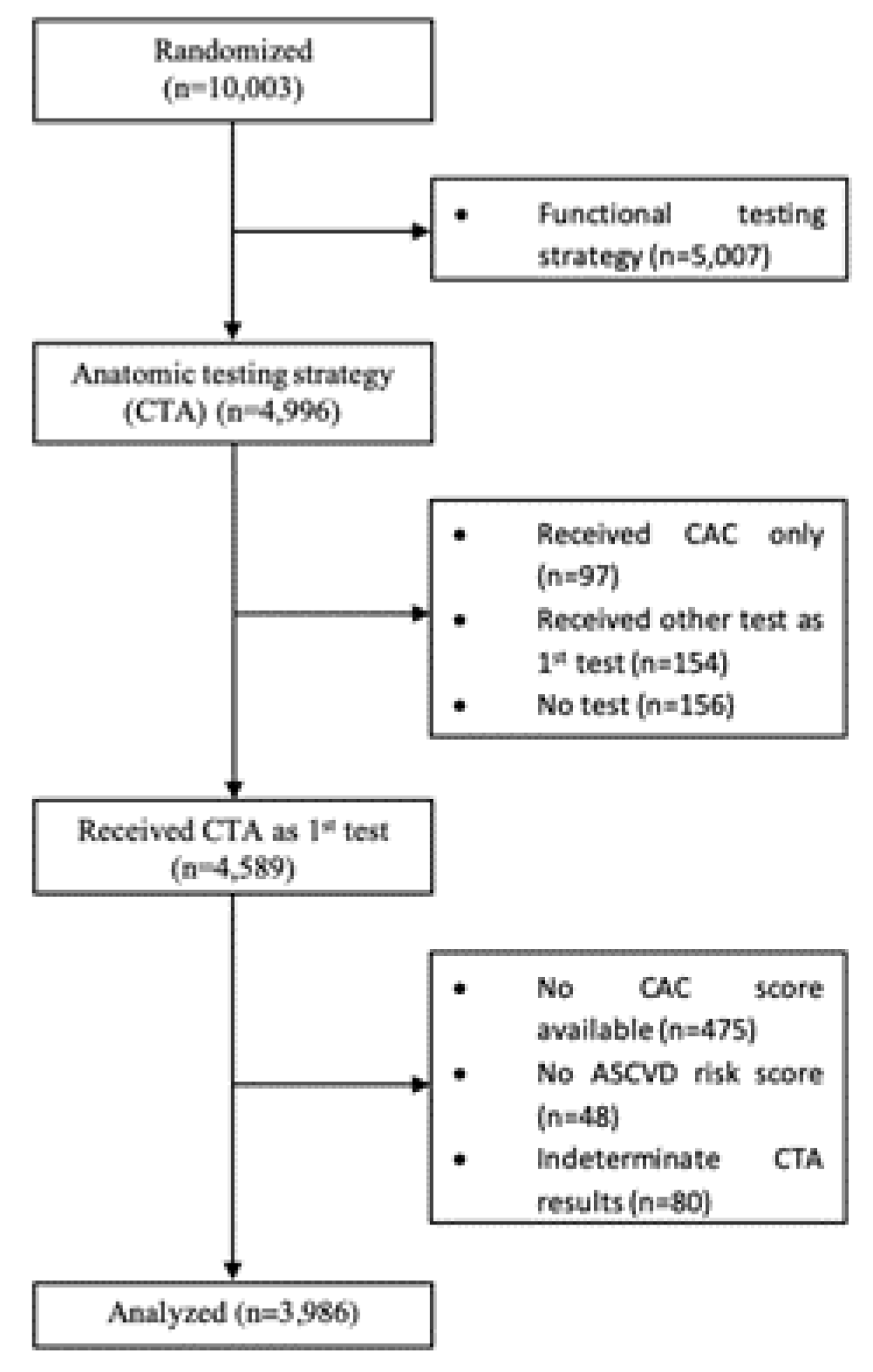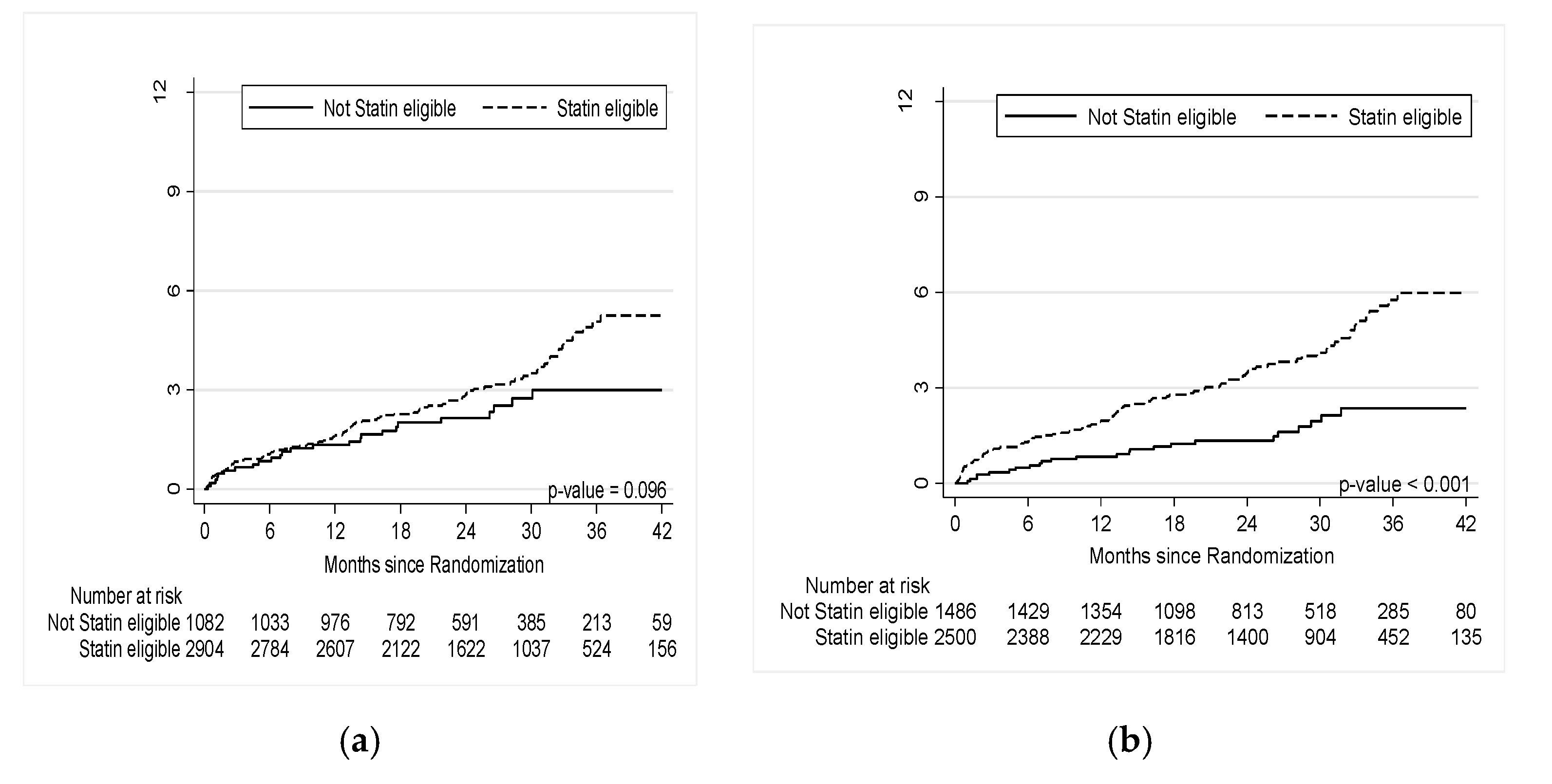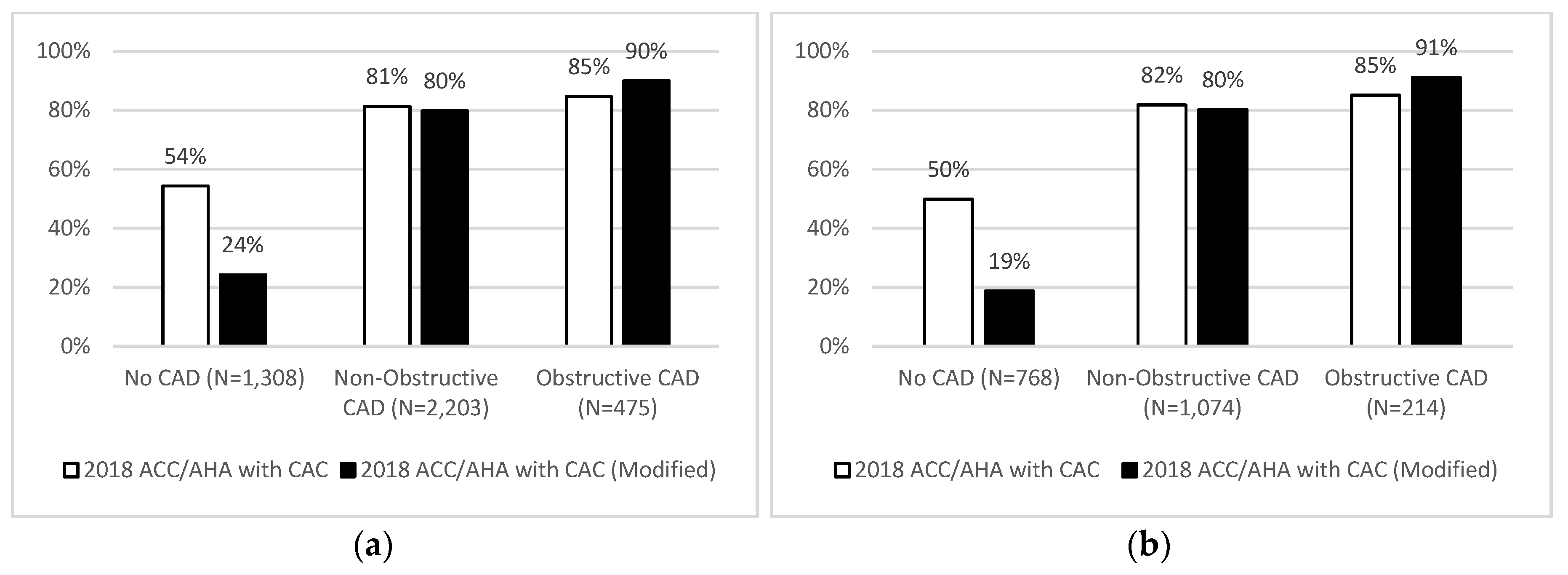Guideline-Based Statin Eligibility, Coronary Artery Stenosis and Cardiovascular Events in Patients with Stable Chest Pain: A Secondary Analysis of the PROMISE Randomized Clinical Trial
Abstract
1. Introduction
2. Methods
2.1. Study Design and Population
2.2. Study Procedures and Coronary CTA
2.3. Guideline-Based Statin Eligibility
2.4. Revision of ASCVD Risk and Modified Statin Eligibility Incorporating Coronary CTA-Detected CAD
2.5. Outcomes
2.6. Statistical Analysis
3. Results
3.1. Study Population
3.2. Guideline-Based Statin Eligibility and Cardiovascular Events
3.3. Modified Statin Eligibility and Cardiovascular Events in all Patients
3.4. Stratified Analysis of Modified Statin Eligibility and Cardiovascular Events in Statin Naïve Patients
4. Discussion
Author Contributions
Funding
Acknowledgments
Conflicts of Interest
Abbreviations
| ACS | Acute Coronary Syndrome |
| ASCVD | Atherosclerotic Cardiovascular Disease |
| CAD | Coronary Artery Disease |
| CTA | Ct Angiography |
| CV | Cardiovascular |
| PCE | Pooled Cohort Equation |
References
- Grundy, S.M.; Stone, N.J.; Bailey, A.L.; Beam, C.; Birtcher, K.K.; Blumenthal, R.S.; Braun, L.T.; de Ferranti, S.; Faiella-Tommasino, J.; Forman, D.E.; et al. 2018 AHA/ACC/AACVPR/AAPA/ABC/ACPM/ADA/AGS/APhA/ASPC/NLA/PCNA Guideline on the Management of Blood Cholesterol. J. Am. Coll. Cardiol. 2018. [Google Scholar] [CrossRef]
- Douglas, P.S.; Hoffmann, U.; Patel, M.R.; Mark, D.B.; Al-Khalidi, H.R.; Cavanaugh, B.; Cole, J.; Dolor, R.J.; Fordyce, C.B.; Huang, M.; et al. Outcomes of Anatomical versus Functional Testing for Coronary Artery Disease. N. Engl. J. Med. 2015, 372, 1291–1300. [Google Scholar] [CrossRef] [PubMed]
- Budoff, M.J.; Möhlenkamp, S.; McClelland, R.; Delaney, J.A.; Bauer, M.; Jöckel, H.K.; Kälsch, H.; Kronmal, R.; Nasir, K.; Lehmann, N.; et al. Multi-Ethnic Study of Atherosclerosis and the Investigator Group of the Heinz Nixdorf RECALL Study, A comparison of outcomes with coronary artery calcium scanning in unselected populations: The Multi-Ethnic Study of Atherosclerosis (MESA) and Heinz Nixdorf RECALL study (HNR). J. Cardiovasc. Comput. Tomogr. 2013, 7, 182–191. [Google Scholar] [CrossRef]
- Hoffmann, U.; Ferencik, M.; Udelson, J.E.; Picard, M.H.; Truong, Q.A.; Patel, M.R.; Huang, M.; Pencina, M.; Mark, D.B.; Heitner, J.F.; et al. Prognostic Value of Noninvasive Cardiovascular Testing in Patients With Stable Chest Pain: Insights From the PROMISE Trial (Prospective Multicenter Imaging Study for Evaluation of Chest Pain). Circulation 2017, 135, 2320–2332. [Google Scholar] [CrossRef] [PubMed]
- Chow, B.J.W.; Small, G.; Yam, Y.; Chen, L.; Achenbach, S.; Al-Mallah, M.; Berman, D.S.; Budoff, M.J.; Cademartiri, F.; Callister, T.Q.; et al. Incremental Prognostic Value of Cardiac Computed Tomography in Coronary Artery Disease Using CONFIRM: COroNary Computed Tomography Angiography Evaluation for Clinical Outcomes: An InteRnational Multicenter Registry. Circ. Cardiovasc. Imaging 2011, 4, 463–472. [Google Scholar] [CrossRef] [PubMed]
- Douglas, P.S.; Hoffmann, U.; Lee, K.L.; Mark, D.B.; Al-Khalidi, H.R.; Anstrom, K.; Dolor, R.J.; Kosinski, A.; Krucoff, M.W.; Mudrick, D.W.; et al. PROspective Multicenter Imaging Study for Evaluation of chest pain: Rationale and design of the PROMISE trial. Am. Heart J. 2014, 167, 796–803. [Google Scholar] [CrossRef]
- Agatston, A.S.; Janowitz, W.R.; Hildner, F.J.; Zusmer, N.R.; Viamonte, M.; Detrano, R. Quantification of coronary artery calcium using ultrafast computed tomography. J. Am. Coll. Cardiol. 1990, 15, 827–832. [Google Scholar] [CrossRef]
- Emami, H.; Takx, R.A.P.; Mayrhofer, T.; Janjua, S.; Park, J.; Pursnani, A.; Tawakol, A.; Lu, M.T.; Ferencik, M.; Hoffmann, U. Nonobstructive Coronary Artery Disease by Coronary CT Angiography Improves Risk Stratification and Allocation of Statin Therapy. JACC Cardiovasc. Imaging 2017, 10, 1031–1038. [Google Scholar] [CrossRef]
- Goff David, C.; Lloyd-Jones Donald, M.; Bennett, G.; Coady, S.; D’Agostino, R.B.; Gibbons, R.; Greenland, P.; Lackland Daniel, T.; Levy, D.; O’Donnell Christopher, J.; et al. 2013 ACC/AHA Guideline on the Assessment of Cardiovascular Risk. Circulation 2014, 129, S49–S73. [Google Scholar] [CrossRef]
- Harrell, F.E., Jr.; Califf, R.M.; Pryor, D.B.; Lee, K.L.; Rosati, R.A. Evaluating the Yield of Medical Tests. JAMA 1982, 247, 2543–2546. [Google Scholar] [CrossRef]
- Gottlieb, I.; Miller, J.M.; Arbab-Zadeh, A.; Dewey, M.; Clouse, M.E.; Sara, L.; Niinuma, H.; Bush, D.E.; Paul, N.; Vavere, A.L.; et al. The Absence of Coronary Calcification Does Not Exclude Obstructive Coronary Artery Disease or the Need for Revascularization in Patients Referred for Conventional Coronary Angiography. J. Am. Coll. Cardiol. 2010, 55, 627–634. [Google Scholar] [CrossRef]
- Pursnani, A.; Massaro, J.M.; D’Agostino, R.B.; O’Donnell, C.J.; Hoffmann, U. Guideline-Based Statin Eligibility, Coronary Artery Calcification, and Cardiovascular Events. JAMA 2015, 314, 134. [Google Scholar] [CrossRef] [PubMed]
- Kim, Y.J.; Hur, J.; Lee, H.-J.; Chang, H.-J.; Nam, J.E.; Hong, Y.J.; Kim, H.Y.; Lee, J.W.; Choi, B.W. Meaning of zero coronary calcium score in symptomatic patients referred for coronary computed tomographic angiography. Eur. Heart J. Cardiovasc. Imaging 2012, 13, 776–785. [Google Scholar] [CrossRef] [PubMed]
- Iwasaki, K.; Matsumoto, T.; Aono, H.; Furukawa, H.; Samukawa, M. Prevalence of non-calcified coronary plaque on 64-slice computed tomography in asymptomatic patients with zero and low coronary artery calcium. Can. J. Cardiol. 2010, 26, 377–380. [Google Scholar] [CrossRef]
- Bittner, D.O.; Mayrhofer, T.; Budoff, M.; Szilveszter, B.; Foldyna, B.; Hallett, T.R.; Ivanov, A.; Janjua, S.; Meyersohn, N.M.; Staziaki, P.V.; et al. Prognostic Value of Coronary CTA in Stable Chest Pain: CAD-RADS, CAC, and Cardiovascular Events in PROMISE. JACC Cardiovasc. Imaging 2019. [Google Scholar] [CrossRef]
- Pencina, M.J.; Navar-Boggan, A.M.; D’Agostino, R.B.S.; Williams, K.; Neely, B.; Sniderman, A.D.; Peterson, E.D. Application of new cholesterol guidelines to a population-based sample. N. Engl. J. Med. 2014. [Google Scholar] [CrossRef]
- Sattar, N.; Preiss, D.; Murray, H.M.; Welsh, P.; Buckley, B.M.; de Craen, A.J.; Seshasai, S.R.K.; McMurray, J.J.; Freeman, D.J.; Jukema, J.W.; et al. Statins and risk of incident diabetes: A collaborative meta-analysis of randomised statin trials. Lancet 2010, 375, 735–742. [Google Scholar] [CrossRef]
- Okkels, J.L.; Per, T.; Erik, P.K.; Steen, S.; Torben, H. Regression of Coronary Atherosclerosis by Simvastatin. Circulation 2004, 110, 265–270. [Google Scholar] [CrossRef]
- Nissen, S.E.; Tuzcu, E.M.; Schoenhagen, P.; Brown, B.G.; Ganz, P.; Vogel, R.A.; Crowe, T.; Howard, G.; Cooper, C.J.; Brodie, B.; et al. Effect of intensive compared with moderate lipid-lowering therapy on progression of coronary atherosclerosis: A randomized controlled trial. JAMA 2004, 291, 1071–1080. [Google Scholar] [CrossRef]
- Cho, Y.-K.; Nam, C.-W.; Koo, B.-K.; Schulman-Marcus, J.; Hartaigh, B.Ó.; Gransar, H.; Lu, Y.; Achenbach, S.; Al-Mallah, M.; Andreini, D.; et al. Usefulness of baseline statin therapy in non-obstructive coronary artery disease by coronary computed tomographic angiography: From the CONFIRM (COronary CT Angiography EvaluatioN For Clinical Outcomes: An InteRnational Multicenter) study. PLoS ONE 2018, 13, e0207194. [Google Scholar] [CrossRef]
- Chow Benjamin, J.W.; Gary, S.; Yeung, Y.; Li, C.; Ruth, M.; Stephan, A.; Mouaz, A.; Daniel, S.B.; Matthew, J.B.; Cademartiri, F.; et al. Prognostic and Therapeutic Implications of Statin and Aspirin Therapy in Individuals With Nonobstructive Coronary Artery Disease. Arterioscler. Thromb. Vasc. Biol. 2015, 35, 981–989. [Google Scholar] [CrossRef]
- Tesche, C.; Plank, F.; de Cecco, C.N.; Duguay, T.M.; Albrecht, M.H.; Varga-Szemes, A.; Bayer, R.R.; Yang, J.; Jacks, I.L.; Gramer, B.M.; et al. Prognostic implications of coronary CT angiography-derived quantitative markers for the prediction of major adverse cardiac events. J. Cardiovasc. Comput. Tomogr. 2016, 10, 458–465. [Google Scholar] [CrossRef] [PubMed]
- Puchner, S.B.; Lu, M.T.; Mayrhofer, T.; Liu, T.; Pursnani, A.; Ghoshhajra, B.B.; Truong, Q.A.; Wiviott, S.D.; Fleg, J.L.; Hoffmann, U.; et al. High-Risk Coronary Plaque at Coronary CT Angiography Is Associated with Nonalcoholic Fatty Liver Disease, Independent of Coronary Plaque and Stenosis Burden: Results from the ROMICAT II Trial. Radiology 2015, 274, 693–701. [Google Scholar] [CrossRef] [PubMed]



| Variables | All Patients (n = 3986) | Not Statin Eligible (n = 1082) | Statin Eligible (n = 2904) | p-Value |
|---|---|---|---|---|
| Age, mean ± SD | 60.5 ± 8.2 | 59.5 ± 9.8 | 60.9 ± 7.4 | 0.001 |
| Male, n (%) | 1936 (48.6) | 345 (31.9) | 1591 (54.8) | 0.001 |
| Race, n (%) | ||||
| White | 3364 (84.4) | 929 (85.9) | 2435 (83.9) | 0.128 |
| Black | 407 (10.2) | 89 (8.2) | 318 (11.0) | 0.011 |
| Other | 215 (5.4) | 64 (5.9) | 151 (5.2) | 0.386 |
| CV risk factors | ||||
| Body-Mass Index (kg/m2), mean ± SD | 30.3 ± 5.9 | 29.3 ± 5.8 | 30.7 ± 5.8 | 0.001 |
| Systolic Blood Pressure (mmHg), mean ± SD | 131.2 ± 16.4 | 127.9 ± 16.7 | 132.4 ± 16.2 | 0.001 |
| Diastolic Blood Pressure (mmHg), mean ± SD | 78.9 ± 10.1 | 77.9 ± 10.6 | 79.2 ± 10.0 | 0.001 |
| Hypertension, n (%) | 2566 (64.4) | 611 (56.5) | 1955 (67.3) | 0.001 |
| Diabetes, n (%) | 808 (20.3) | 0 (0.0) | 808 (27.8) | 0.001 |
| Dyslipidemia, n (%) | 2693 (67.6) | 698 (64.5) | 1995 (68.7) | 0.013 |
| Family History of Premature CAD, No./Total No. (%) | 1307/3976 (32.9) | 277/1079 (25.7) | 1030/2897 (35.6) | 0.001 |
| Peripheral Arterial or Cerebrovascular Disease, No./Total No. (%) | 208 (5.2) | 6 (0.6) | 202 (7.0) | 0.001 |
| CAD Risk Equivalent, n (%) | 957 (24.0) | 6 (0.6) | 951 (32.8) | 0.001 |
| Metabolic Syndrome, n (%) | 1465 (36.8) | 203 (18.8) | 1262 (43.5) | 0.001 |
| Current or Past Tobacco Use, No./Total No. (%) | 2036 (51.1) | 255 (23.6) | 1781 (61.3) | 0.001 |
| Sedentary Lifestyle, No./Total No. (%) | 1917/3978 (48.2) | 503/1079 (53.4) | 1414/2899 (48.8) | 0.239 |
| History of Depression, No. (%) | 766 (19.2) | 205 (19.0) | 561 (19.3) | 0.821 |
| Risk Burden | ||||
| No Risk Factors, No. (%) | 103 (2.6) | 52 (4.8) | 51 (1.8) | 0.001 |
| Mean No. of Risk Factors Per Patient | 2.36 ± 1.08 | 1.70 ± 0.84 | 2.61 ± 1.05 | 0.001 |
| Mean Combined Diamond and Forrester and Coronary Artery Surgery Study Risk Score | 53.2 ± 21.2 | 45.1 ± 20.8 | 56.2 ± 20.5 | 0.001 |
| Framingham Risk Score Categories, No./Total No. (%) | 0.001 | |||
| Low Risk (6%) | 262 (6.6) | 230 (21.3) | 32 (1.1) | |
| Intermediate Risk (6–20%) | 2088 (52.4) | 732 (67.7) | 1356 (46.7) | |
| High Risk (20%) | 1636 (41.0) | 120 (11.1) | 1516 (52.2) | |
| Framingham Risk Score, median (IQR) | 17.0 (10.5–27.9) | 8.8 (6.3–13.3) | 20.8 (13.9–31.6) | 0.001 |
| ASCVD Risk, No./Total No. (%) | 0.001 | |||
| Low Risk (7.5%) | 1302 (32.7) | 782 (72.3) | 520 (17.9) | |
| Elevated Risk (≥7.5%) | 2684 (67.3) | 300 (27.7) | 2,384 (82.1) | |
| ASCVD Risk Median (IQR) | 11.0 (6.1–19.2) | 4.4 (3.0–8.6) | 13.2 (8.5–20.7) | 0.001 |
| Lipids, mean ± SD | ||||
| Total Cholesterol, mg/dL | 195.9 ± 34.5 | 195.2 ± 29.1 | 196.1 ± 36.3 | 0.430 |
| LDL Cholesterol, mg/dL | 116.1 ± 27.4 | 115.7 ± 24.3 | 116.2 ± 28.4 | 0.530 |
| HDL Cholesterol, mg/dL | 51.4 ± 12.1 | 55.5 ± 12.8 | 49.9 ± 11.5 | 0.001 |
| Triglycerides, mg/dL | 155.7 ± 158.4 | 125.2 ± 65.5 | 166.5 ± 178.9 | 0.001 |
| Baseline Medications, No./Total No. (%) | ||||
| Beta-Blocker | 953/3817 (25.0) | 207/1028 (20.1) | 746/2789 (26.8) | 0.001 |
| ACE Inhibitor or ARB | 1655/3817 (43.4) | 332/1028 (32.3) | 1323/2789 (47.4) | 0.001 |
| Statin | 1743/3817 (45.7) | 405/1028 (39.4) | 1338/2789 (48.0) | 0.001 |
| Aspirin | 1722/3817 (45.1) | 395/1028 (38.4) | 1327/2789 (47.6) | 0.001 |
| Clopidogrel | 48/3817 (1.3) | 8/1028 (0.8) | 40/2789 (1.4) | 0.139 |
| Prasugrel | 1/3817 (0.03) | 0/1028 (0.0) | 1/2789 (0.04) | 1.000 |
| Warfarin | 59/3817 (1.6) | 15/1028 (1.5) | 44/2789 (1.6) | 0.883 |
| Primary Presenting Symptom, No./Total No. (%) | ||||
| Chest Pain | 2930 (73.5) | 817 (75.5) | 2113 (72.8) | 0.090 |
| Dyspnea on Exertion | 569 (14.3) | 132 (12.2) | 437 (15.1) | 0.022 |
| Other | 485 (12.2) | 133 (12.3) | 352 (12.1) | 0.913 |
| Type of Angina, No. (%) | 0.001 | |||
| Typical | 440 (11.0) | 96 (8.9) | 344 (11.9) | |
| Atypical | 3125 (78.4) | 843 (77.9) | 2282 (78.6) | |
| Nonanginal Pain | 421 (10.6) | 143 (13.2) | 278 (9.6) | |
| Pretest Likelihood of Significant CAD (Physician Based), No./Total No. (%) | 0.001 | |||
| Very Low (10%) | 228/3980 (5.7) | 76/1080 (7.0) | 152/2900 (5.2) | |
| Low (10–30%) | 1228/3980 (30.9) | 418/1080 (38.7) | 810/2900 (27.9) | |
| Intermediate (31–70%) | 2335/3980 (58.7) | 562/1080 (52.0) | 1773/2900 (61.1) | |
| High (71–90%) | 174/3980 (4.4) | 21/1080 (1.9) | 153/2900 (5.3) | |
| Very High (90%) | 15/3980 (0.4) | 3/1080 (0.3) | 12/2900 (0.4) | |
| MACE, No. (%) | ||||
| Death, Non-Fatal MI or Hospitalization For UAP | 122 (3.1) | 25 (2.3) | 97 (3.3) | |
| CV Death, Non-Fatal MI or Hospitalization For UAP | 96 (2.4) | 21 (1.9) | 75 (2.6) | |
| CV Death or Non-Fatal MI | 51 (1.3) | 11 (1.0) | 40 (1.4) | |
| Non-Fatal MI | 20 (0.5) | 5 (0.5) | 15 (0.5) |
| Coronary CTA | Total | No CAD | Non-obstructive CAD | Obstructive CAD |
|---|---|---|---|---|
| ALL PATIENTS | n = 3986 Event Rate 3.1% | n = 1308 Event Rate 0.9% | n = 2203 Event Rate 2.9% | n = 475 Event Rate 9.9% |
| Statin eligibility by 2018 ACC/AHA Guidelines with CAC | ||||
| STATIN ELIGIBLE | n = 2904 (72.9) Event Rate 3.3% | n = 710 (54.3) Event Rate 1.1% | n = 1792 (81.3) Event Rate 2.8% | n = 402 (84.6) Event Rate 9.7% |
| NOT STATIN ELIGIBLE | n = 1082 (27.2) Event Rate 2.3% | n = 598 (45.7) Event Rate 0.7% | n = 411 (18.7) Event Rate 3.2% | n = 73 (15.4) Event Rate 11.0% |
| Statin Eligibility by 2018 ACC/AHA Guidelines with CAC incorporating coronary CTA-detected CAD | ||||
| STATIN ELIGIBLE | n = 2500 (62.7) Event Rate 3.9% | n = 316 (24.2) Event Rate 1.3% | n = 1757 (79.8) Event Rate 2.9% | n = 427 (89.9) Event Rate 10.3% |
| NOT STATIN ELIGIBLE | n = 1486 (37.3) Event Rate 1.6% | n = 992 (75.8) Event Rate 0.8% | n = 446 (20.3) Event Rate 2.9% | n = 48 (10.1) Event Rate 6.3% |
| Coronary CTA | Total | No CAD | Non-obstructive CAD | Obstructive CAD |
|---|---|---|---|---|
| STATIN NAIVE PATIENTS | n = 2074 Event Rate 3.2% | n = 786 Event Rate 1.2% | n = 1074 Event Rate 3.1% | n = 214 Event Rate 11.2% |
| Statin eligibility by 2018 ACC/AHA Guidelines with CAC | ||||
| STATIN ELIGIBLE | n = 1451 (70.0) Event Rate 3.4% | n = 391 (49.8) Event Rate 1.3% | n = 878 (81.8) Event Rate 2.7% | n = 182 (85.1) Event Rate 11.0% |
| NOT STATIN ELIGIBLE | n = 623 (30.0) Event Rate 2.7% | n = 395 (50.3) Event Rate 1.0% | n = 196 (18.3) Event Rate 4.6% | n = 32 (15.0) Event Rate 12.5% |
| Statin Eligibility by 2018 ACC/AHA Guidelines with CAC incorporating coronary CTA-detected CAD | ||||
| STATIN ELIGIBLE | n = 1203 (58.0) Event Rate 4.0% | n = 147 (18.7) Event Rate 1.4% | n = 861 (80.2) Event Rate 2.8% | n = 195 (91.1) Event Rate 11.3% |
| NOT STATIN ELIGIBLE | n = 871 (42.0) Event Rate 2.1% | n = 639 (81.3) Event Rate 1.1% | n = 213 (19.8) Event Rate 4.2% | n = 19 (8.9) Event Rate 10.5% |
© 2020 by the authors. Licensee MDPI, Basel, Switzerland. This article is an open access article distributed under the terms and conditions of the Creative Commons Attribution (CC BY) license (http://creativecommons.org/licenses/by/4.0/).
Share and Cite
Pursnani, A.; Taron, J.; Mayrhofer, T.; Lu, M.T.; Ferencik, M.; Ladapo, J.A.; Douglas, P.S.; Hoffmann, U. Guideline-Based Statin Eligibility, Coronary Artery Stenosis and Cardiovascular Events in Patients with Stable Chest Pain: A Secondary Analysis of the PROMISE Randomized Clinical Trial. J. Clin. Med. 2020, 9, 3076. https://doi.org/10.3390/jcm9103076
Pursnani A, Taron J, Mayrhofer T, Lu MT, Ferencik M, Ladapo JA, Douglas PS, Hoffmann U. Guideline-Based Statin Eligibility, Coronary Artery Stenosis and Cardiovascular Events in Patients with Stable Chest Pain: A Secondary Analysis of the PROMISE Randomized Clinical Trial. Journal of Clinical Medicine. 2020; 9(10):3076. https://doi.org/10.3390/jcm9103076
Chicago/Turabian StylePursnani, Amit, Jana Taron, Thomas Mayrhofer, Michael T. Lu, Maros Ferencik, Joseph A. Ladapo, Pamela S. Douglas, and Udo Hoffmann. 2020. "Guideline-Based Statin Eligibility, Coronary Artery Stenosis and Cardiovascular Events in Patients with Stable Chest Pain: A Secondary Analysis of the PROMISE Randomized Clinical Trial" Journal of Clinical Medicine 9, no. 10: 3076. https://doi.org/10.3390/jcm9103076
APA StylePursnani, A., Taron, J., Mayrhofer, T., Lu, M. T., Ferencik, M., Ladapo, J. A., Douglas, P. S., & Hoffmann, U. (2020). Guideline-Based Statin Eligibility, Coronary Artery Stenosis and Cardiovascular Events in Patients with Stable Chest Pain: A Secondary Analysis of the PROMISE Randomized Clinical Trial. Journal of Clinical Medicine, 9(10), 3076. https://doi.org/10.3390/jcm9103076





